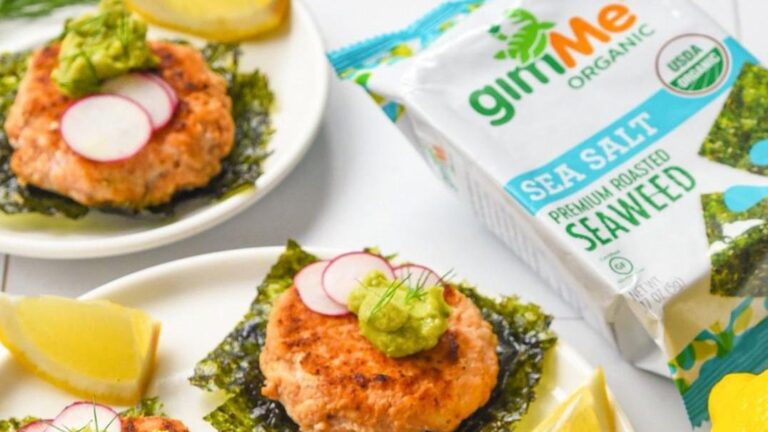
Gimme reimagines how seaweed is incorporated into meals.
Annie Chun, who grew up in South Korea, already has one successful business under her belt. Now, she’s building her second one with just one ingredient: seaweed.
When Chun came to San Francisco in the late 1970s, she ended up in the food business, starting like so many other food entrepreneurs—at the farmer’s market. In the early 90s, she hit the local markets with her Asian-inspired sauces. In 2009, she and husband Steve Broad, who is also her trusty business partner, sold that first venture, Annie’s Chun’s foods to CJ’s, a South Korean company, after reportedly reaching $15 million in annual sales.
Gimme founders, Steve Broad and Annie Chun.
In 2012, Chun wanted to do a different business that reminded her of the seaweed snacks she grew up having in South Korea. GimMe was born. “There was nothing like it on the market. And certainly not organic.”
Chun and Broad had a tall task ahead. Not only were they transforming the way seaweed was harvested from off the coast of South Korea, but they had to introduce a relatively new concept to American consumers: a snack with a chip-like texture, but an earthy, salty taste of the sea.
The duo had benefited from the success of their previous company; so they put some of the gains from that venture to start this new company. “With the sauces, there were too many individual ingredients to make it organic. It was hard to get copackers to also go through that extra effort. But with seaweed, it’s just one main ingredient,” Chun notes.
The Bay Area resident who had been a proponent of organic foods, now had a chance to bring in an entirely organic product line, while working closely with her supply chain.
Seaweed, a staple in Japanese and Korean diets, had been limited to the ethnic food aisles in the US. Plus, Chun wanted to make it more palatable for American tastes. So, she developed a crispier, chip-like version that comes in a variety of flavors: teriyaki, wasabi, sesame, avocado oil, chili lime, and more.
Plus, seaweed is a nutrient dense food, Chun explains. “If you don’t have anything else to add to rice, just crush some seaweed and put it on top.” Seaweed contains iodine, omega 3, iron, calcium, fiber, protein — among other nutrients. “For its weight, it’s a very nutrient dense food,” explains Broad. “And if we need to look for more vegetarian options, it’s a great choice, given that we’ve overfished our seas.”
It’s also become a popular ingredient for its environmental attributes. Seaweed can be grown in regenerative organic farms, according to the Ellen MacArthur Foundation. Unlike land-based farms that need large amounts of external inputs for their crops, seaweed can be a more low-maintenance crop. Seaweed can help regenerate the marine ecosystem by reducing ocean acidification and creating a habitat for countless marine species. It’s estimated that a 20-acre farm can sequester 9,000 kilograms of CO2 and 300 kilograms of nitrogen annually.
GimMe states that one ton of seaweed can sequester about one to four tons of CO2 per year, and generally can sequester two to five times the amount of CO2 of tropical forests like the Amazon.
Gimme sources organic seaweed from these farms off the coast of South Korea.
Growing it organically adds another layer to this environmental story. Broad explains that their process differs from conventional growers. GimMe’s seaweed is grown in deeper waters in Jangheung Bay, he says. “They use buoys. When the seaweed is immersed in the water, it grows. Then they rotate it and expose it to the sun above water. That kills any species that can harm the seaweed and make it turn brown.”
This natural approach to farming seaweed avoids the use of any chemicals or additives that could potentially harm marine life.
When Chun first pitched the organic seaweed to some national retail grocers, she didn’t really receive an enthusiastic response. It was when she went to Whole Foods, she says, “The buyer got it immediately and understood the value of organic. And then launched us nationally.”
For Chun, growing GimMe has been a combination of sharing her Korean heritage and creating snacks that are healthy and affordable. “For me, this is a company about sharing, sharing my roots but also sharing something that is good for our health.”
Packing it, though, hasn’t been easy. The seaweed crisps need to kept fresh; the packaging therefore has to have a high oxygen barrier. Thus for years, they were housed in plastic trays, wrapped in a film. Broad explains that they’ve now gotten rid of the plastic trays and are constantly looking for better solutions. GimMe works with OSC, One Step Closer Packaging Collaborative, in the Bay area, which consists of similar sustainability-minded companies who are looking for more eco-friendly solutions to packaging.
As a company of about 20 staff, Broad says, “We’re still small, and it’s hard to change a packaging industry on our own. But we’re constantly trying to find better options.”
During the pandemic as sushi restaurants closed, GimMe’s nori became a staple for DIY sushi makers at home, he adds. That’s helped the business get a new demographic on board. “But what’s amazing is we have kids sharing the snacks at schools with each other, and that’s exposing kids to seaweed. Plus, we’ve seen a few big hits with TikTok.”
So could the youth be helpful in making seaweed more popular in America? Broad hopes so. “Our data tells us that seaweed is at about 4% penetration in American houses. So it’s still early days.”